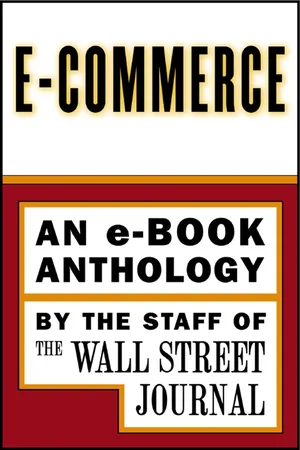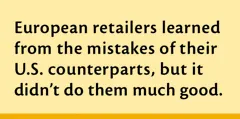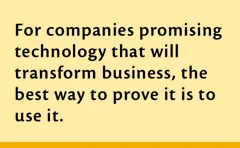![]()
ONE
A Head Start
BY DAVID PRINGLE
April 17, 2000
When department-store company Karstadt-Quelle AG started an online shopping mall back in October 1996, Germany’s retail industry raised a collective eyebrow.
After all, at that time, fewer than 750,000 German households had access to the World Wide Web, and the Internet was widely regarded as being only for teenage technology enthusiasts.
But things changed quickly, and by the end of 1997, five million Germans were online, according to Jupiter Communications, a New York–based research group, giving Karstadt a promising prospective market.
What was it that prompted the retail giant to rush into e-commerce so early—six weeks before it even got around to putting up a basic corporate Web site? Credit a combination of foresight and fear.
“It was very early for Germany, but we had known about the scenario in the U.S.,” says Holger Pleines, manager of e-commerce at Karstadt. “And we had seen that we could have a problem in the future through Internet technology: The producer of items could sell direct to the customer, and we could lose revenue in our department stores.”
That’s been the good news for Karstadt and several other European retailers: Because Europe was about two years behind the U.S. in adopting the Internet as a retail channel, European retailers had a chance to see beforehand where things were headed. And with that glimpse of the future, they could try to steer it in their direction.
What’s more, because there wasn’t a lot of interest in Europe in 1997 in funding Internet start-ups, conventional retailers had a golden opportunity to lock out the start-ups before they could get going. “Venture-capital money was still relatively scarce,” says Joe Sawyer, a senior analyst with Forrester Research Inc. in Cambridge, Mass., “and it was hard to conjure up a lot of excitement about Internet pure plays.”
So, how well have these high-street retailers fared? Well, that’s the bad-news part of the story: It seems many haven’t been able to capitalize on the early start. Surveys conducted in January by London-based research firm MMXI Europe show that brick-and-mortar retailers own none of the 10 most-visited retail sites in the U.K. In Germany, two conventional retailers ranked in the top 10, and in France, three made the top tier. (Two of the top 10 online merchants in the U.S. are owned by conventional retailers, according to MMXI.)
Most of the leading retail sites in Europe either are owned by American Internet companies, notably Amazon.com Inc., or are run by local mail-order firms such as the U.K.’s Software Warehouse PLC, which founded the popular site Jungle.com.
Karstadt started early but had to relaunch its online mall, My-World.de., at the end of 1997 after consumers complained that its initial version was difficult to navigate. “Karstadt sunk a ton of money into doing their site over and over again,” says Mr. Sawyer at Forrester.
My-World is only the 26th most-visited retail site in Germany, according to MMXI. Mr. Pleines won’t disclose what proportion of Karstadt’s sales currently come through My-World.de, which now stocks 1.2 million product lines. He says only, “It is rising fast from a small base.”
Another retailer found that starting early was no guarantee of success. Nick Jones, a London-based analyst with Jupiter, says that U.K. retailer Argos Ltd. was selling online in early 1996, but the company’s Web site offered only 12 product lines and sales were very slow. Argos has since increased its product range significantly, and sales have picked up.
Still, analysts say the brick-and-mortar companies in Europe are in a relatively strong position compared with their U.S. counterparts. Mr. Sawyer at Forrester says that traditional European retailers are neck-and-neck with the local dot-coms in terms of the quality of their online stores—though they trail the international dot-coms and local mail-order firms—while American retailers are still generally trying to catch up with the Internet start-ups.
What’s more, a handful of European brick-and-mortar companies did benefit from getting onto the Web early. Book, video and computer retailer FNAC, owned by Pinault Printemps Redoute SA, made its Internet debut in 1997. It now has the 10th most popular retail site in France, according to MMXI Europe. Jean-Christophe Hermann, chief executive officer of FNAC.com, says the company sold $7 million of products through the Internet in 1999. Although this is a relatively small figure compared with sales by Web sites in other countries, only 16% of French adults use the Internet, according to International Data Corp., Framingham, Mass.
And U.K. grocer Tesco PLC, which started e-commerce trials over the Internet in 1996, says it sells more than $3 million of groceries a week online in the U.K. Orders average about $140, and Tesco, which levies an $8 delivery charge, says the profit margin on each delivery is 7% to 8%.
One drawback for Tesco is its service is still very limited in geographic terms. U.K. consumers can buy Tesco groceries online only if they live near one of the 145 stores from which the orders are fulfilled. More than 450 Tesco stores have yet to be brought into the scope of the service.
And Russell Craig, spokesman for Tesco, says it can take a year to persuade people to buy fresh food online. “One of the problems that we face is that in the beginning people will buy soap powder . . . but they won’t buy fresh food such as meat and produce, which they like to touch and feel,” he says. “It takes a lot of trust.”
Mr. Pringle is a staff reporter with The Wall Street Journal’s London bureau.
![]()
TWO
Choice and Trust
BY JOHN BUSKIN
April 17, 2000
Perhaps the keenest observer of public attitudes toward privacy in the 20th century is Alan Westin. Among his credentials: professor emeritus of public law and government at Columbia University; publisher of the journal Privacy & American Business; author of numerous books on privacy; member of many federal and state privacy commissions; and designer of more than 40 privacy surveys.
In all, Mr. Westin has spent more than four decades studying the public’s attitude toward privacy. His conclusion about data collection online? Tell people you’re doing it, and they won’t mind.
In his research into privacy, Mr. Westin divides society into three camps whose membership he analyzes and measures. On the extremes are the Privacy Fundamentalists (25%) on one side and the Privacy Unconcerned (20%) at the other. He calls the 55% in the middle Privacy Pragmatists. They volunteer their personal data, but only after answering four basic questions: What’s the benefit to me? What are the risks? What are the safeguards? Do I trust you?
When isolating Internet users, the 25% number for Privacy Fundamentalists rises to between 30% and 35%. In addition, “Net users are more activist in their refusals.”
And as a result of media attention on stories like the DoubleClick situation, there is movement from the Pragmatist camp to the Fundamentalists.
Last November, however, Mr. Westin and Privacy & American Business completed a survey on Internet users’ attitudes toward privacy for DoubleClick. A key conclusion the survey reached: Give people a choice, and they’re not so fundamentalist. “More than two-thirds of Internet users (68%) say they would provide personal information in order to receive tailored banner ads, if notice and opt out are provided,” the study concluded.
Mr. Westin stresses that “notice and choice” were critical to user agreement. In light of the survey’s revelation, why did DoubleClick forge ahead independent of those conditions? Mr. Westin suggests, “They didn’t understand the implications of the results.”
Indeed, another poll designed by Mr. Westin confirms that consumers are more than willing to give up some personal data—as long as they have the choice to do so.
The poll, conducted by Harris Interactive and BusinessWeek, found an interesting schism. “Consumers think there’s more data collection going on than there actually is,” says Harris Interactive Senior Vice President David Krane, “but a low percentage of people feel victimized.”
In another Westin-designed Harris poll, “a minority of consumers in three countries [the U.S., Germany and the U.K.] say they are interested in receiving marketing material,” says Mr. Krane. “Yet, in far greater numbers, consumers view personalized marketing [for which cookies are essential] as ‘a good thing.’ ”
As for the future, Mr. Westin says, “I don’t believe pseudonymous transactions are where things are going. Trusted brands will begin to dominate the transactional landscape.” But that will only result from companies engaging in “a set of activities that earn that trust.”
One action he singles out as crucial is the corporate-wide hiring of high-level privacy officers. (The Double-Click editorial also publicized their recent hiring of a privacy officer.) And though Mr. Westin doesn’t see eye to eye with most of those whom he labels Fundamentalists, he feels strongly that “you need impassioned people to alert society to dangerous trends. If the privacy activist did not exist, I would want to invent him.”
He defines the pro-privacy forces as bipartisan and multi-ideological, and foresees “a roar of legislation” coming up.
Mr. Buskin is editor of dowjones.net, the intranet for Dow Jones & Company, publisher of The Wall Street Journal.
![]()
THREE
Setting an Example
BY LEE GOMES
April 17, 2000
The technology industry, that fountainhead of buzz phrases, has an expression to describe what happens when a company uses its own products. It’s called, poetically enough, “eating your own dog food.”
Most of the biggest names in the computer world are avid puppy-chow chompers. At Microsoft Corp., for example, software developers working on the next version...


